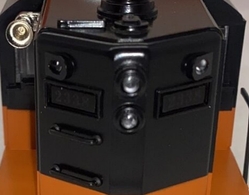With the success of my headlight/taillight install in my #60, my next project is my new 18565 Lionel Milwaukee Road GP9. I've attached a picture of the inside top shell, and it is very basic. One incandescent bulb on each end of the frame. I've also attached a picture of the front end (the back is the same). There are 2 headlights, two other lights, and the lighted boards. The opposite end is totally dark based on the direction. The cab is lit only in the forward direction.
I tried to look up here, and via a web search, what lights should be lit, and couldn't find anything. The question is what is most prototypical.
Should the head lights on the trailing end be red, or is it correct to have them totally off? Should the board numbers on both ends always be lit? What about the lights above the boards? Are they supposed to be a color? I imagine the cab being unlit in the reverse direction is only because of the way the lights are installed.




















